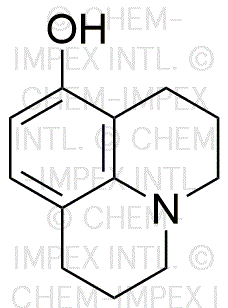8-Hydroxyjulolidine is widely utilized in research focused on:
- Fluorescent Dyes: This compound serves as a key component in the development of fluorescent dyes used in biological imaging, allowing researchers to visualize cellular processes with high precision.
- Organic Electronics: It is applied in the fabrication of organic light-emitting diodes (OLEDs), enhancing the efficiency and color quality of displays in consumer electronics.
- Photochemical Studies: The compound is used in photochemical research, helping scientists understand light-induced reactions, which can lead to advancements in solar energy technologies.
- Analytical Chemistry: 8-Hydroxyjulolidine acts as a reagent in various analytical techniques, aiding in the detection and quantification of specific compounds in complex mixtures.
- Pharmaceutical Development: Its properties make it a candidate for developing new pharmaceutical agents, particularly in the field of neurochemistry, where it may help in studying neurotransmitter systems.
General Information
Properties
Safety and Regulations
Applications
8-Hydroxyjulolidine is widely utilized in research focused on:
- Fluorescent Dyes: This compound serves as a key component in the development of fluorescent dyes used in biological imaging, allowing researchers to visualize cellular processes with high precision.
- Organic Electronics: It is applied in the fabrication of organic light-emitting diodes (OLEDs), enhancing the efficiency and color quality of displays in consumer electronics.
- Photochemical Studies: The compound is used in photochemical research, helping scientists understand light-induced reactions, which can lead to advancements in solar energy technologies.
- Analytical Chemistry: 8-Hydroxyjulolidine acts as a reagent in various analytical techniques, aiding in the detection and quantification of specific compounds in complex mixtures.
- Pharmaceutical Development: Its properties make it a candidate for developing new pharmaceutical agents, particularly in the field of neurochemistry, where it may help in studying neurotransmitter systems.
Documents
Safety Data Sheets (SDS)
The SDS provides comprehensive safety information on handling, storage, and disposal of the product.
Product Specification (PS)
The PS provides a comprehensive breakdown of the product’s properties, including chemical composition, physical state, purity, and storage requirements. It also details acceptable quality ranges and the product's intended applications.
Certificates of Analysis (COA)
Search for Certificates of Analysis (COA) by entering the products Lot Number. Lot and Batch Numbers can be found on a product’s label following the words ‘Lot’ or ‘Batch’.
Numéro de catalogue
Numéro de lot/série
Certificates Of Origin (COO)
This COO confirms the country where the product was manufactured, and also details the materials and components used in it and whether it is derived from natural, synthetic, or other specific sources. This certificate may be required for customs, trade, and regulatory compliance.
Numéro de catalogue
Numéro de lot/série
Safety Data Sheets (SDS)
The SDS provides comprehensive safety information on handling, storage, and disposal of the product.
DownloadProduct Specification (PS)
The PS provides a comprehensive breakdown of the product’s properties, including chemical composition, physical state, purity, and storage requirements. It also details acceptable quality ranges and the product's intended applications.
DownloadCertificates of Analysis (COA)
Search for Certificates of Analysis (COA) by entering the products Lot Number. Lot and Batch Numbers can be found on a product’s label following the words ‘Lot’ or ‘Batch’.
Numéro de catalogue
Numéro de lot/série
Certificates Of Origin (COO)
This COO confirms the country where the product was manufactured, and also details the materials and components used in it and whether it is derived from natural, synthetic, or other specific sources. This certificate may be required for customs, trade, and regulatory compliance.


